Enslaving Your Time
I have every reason to believe that Enslaved is going to be a great game when it finally releases this October. The developer, Ninja Theory, were the masterminds behind one of my favorite games in all of the PlayStation 3 library, Heavenly Sword. Enslaved’s visual style is one of the most unique to come along in years. And to top it off, the game has some fairly obvious high-profile influences from Gears of War to the highly lauded Ico.
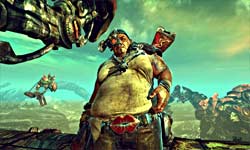
Right now, however, it’s in somewhat rough shape. When playing the game it’s impossible not to see immense potential. I’m just not sure the game was ready to be shown.
Enslaved is based on a Chinese novel called Journey to the West in which humans are randomly abducted by mysterious ships, taken into the West, and never seen again. We don’t know many of the details yet, but we’re already intrigued by this interesting premise. Mostly because we’re so incredibly tired of space marine war stories and high fantasy.
The demo begins with some beautiful visuals that serve as a wonderful display of Enslaved extraordinarily vibrant graphical style. We expected nothing less from the developer of the drop dead gorgeous Heavenly Sword. It’s a unique take on the tired, old post-apocalyptic setting. There are ruins everywhere, but this setting could potentially tell a different story than most apocalypse-based tales. Rather than a dusty, ruined metropolis, we see a city in ruins covered in vegetation. In this world, it’s more likely that the human race has simply neglected these civilizations than that we were wiped out in nuclear holocaust. Colorful flowers and endless green cover every wall and serve as a reminder of how fixated on machines and concrete the industry has become.
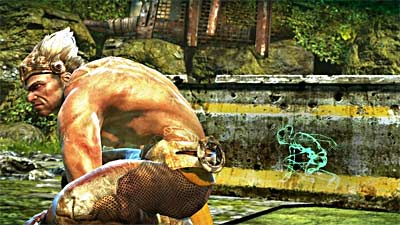
The gameplay is a mixture of combat and platforming. Here’s where things get a little dicey. The combat in Enslaved needs a lot of work. For starters, there’s no type of lock-on feature. In most combat games there’s a sort of ‘magnetism’ that sticks you to an enemy as you’re hitting them. It helps prevent the frustration of accidentally veering off to the side in mid-combo (then having to spend the next few moves viciously punishing the air). Enslaved doesn’t have this (or it’s toned down to such a degree that it didn’t do very much), and it shows immediately.
As a result, the combos tend to fall flat. Instead of an increasingly punishing amount of damage, we usually weren’t able to hit the enemy after the first few swings. To be fair, though, this system is more challenging than your average beat-em-up. Landing a full combo is brutal and satisfying, though far too infrequent.
My skepticism does not extend to the game’s animations though. Ninja Theory is once again proving that they are masters of visual effects. Though many will argue as to the depth and greatness of their games, it’s fairly difficult to debate how amazing this game looks in motion. The main character, Monkey (yeah, I know), even seems to have slight characteristics of apish movement.
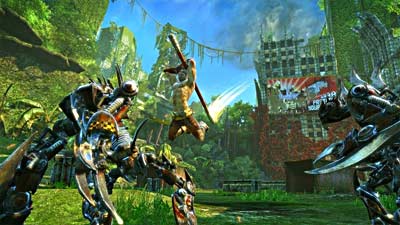
This isn’t just a completely average brawler, though. They’ve got a few unique tricks up their sleeve that should help to make this a bit more interesting. For instance, they have a mechanic that allows you to make use of your female accomplice. On your command she can stand up from behind cover waving her arms around. This will draw all enemy fire and allow you a few precious moments to make your move. The demo was short, so we weren’t able to see many of the ways in which you can use your partner to aid you, but the idea itself is interesting. It made me think of another such game that worked in a similar way, Ico. Obviously, this game is a lot more heavy-handed than that epic of minimalism, but the concept is the same. Grow a relationship between characters by making them constantly interact on screen. Although if that’s their goal, then they should probably rethink their design of the large-breasted female character with torn clothing. Monkey is just as sexualized though, to be fair.
We’ve been wanting to see what Ninja Theory was working on for several years, and now that we’ve gotten that chance we’ve come away mostly impressed. The framework for a fantastic game is certainly here. There are some issues still nagging, but they don’t seem critical. The issues that I noted could very well be chalked up to a lack of polish evident in all games pre-release.
We’re certainly hoping that’s the case, because we’re really looking forward to romping in Enslaved’s world when it releases this October.
Game Features:
Trip See-Monkey Do
April 5, 2010 – I suppose the whole of a product really can be greater than the sum of its parts. At least I hope so, and I imagine Ninja Theory is with me on this one. They have a history of partial successes and, if anyone has had reason to try-try again, it’s them. The developer’s last major effort, Heavenly Sword, was another in a line of games that critics and gamers really wanted to like. It had lofty goals: a deep and engaging combat mechanic, a decidedly high-brow art style seemingly influenced by the mythology of ancient Asian tradition, and memorable characters (specifically villains).

Unfortunately, the outcome didn’t quite meet the hopes of gamers on either side of the industry. The result – much like a night of watching American Idol – left gamers with mixed feelings about the collective effort of the talents involved. It was pitchy, though at times it hit an odd melody and there were even the occasional high notes. Such has been the trademark of many of Ninja Theory’s recent labors.
You’ve got to give them credit, though, the ninjas still plan to change the world (by the way, apparently, members of the team actually have business cards that say ‘ninja’ on them). And indeed they will-if their production schedule stays true-later this year. Ninja Theory’s new project, Enslaved: Odyssey to the West, may just be the stiff wind to get their sails moving again. It’s a tough time for studios all around but developers with mid-range successes and generally more tepid receptions have really been under the gun as of late. A successful neo-franchise could mean a lot for a developer like Ninja Theory. You can be sure they’re going put their best foot forward here.
For anyone familiar with classic platformers like Jak and Daxter, Ratchet and Clank, or to go back a bit further, Banjo-Kazooie, Enslaved: Odyssey to the West looks at first glance like a welcome return to the days of lush, colorful locals, over-the-top attacks, and stressful (and comical) partnerships; Enslaved: Odyssey to the West calls to mind all the right memories of some these classics with its very verdant interpretation of the future.
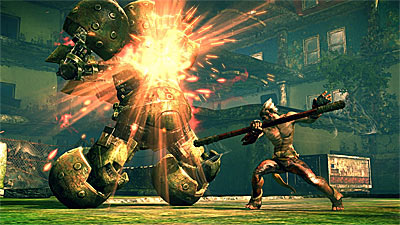
A century and a half into the future, mankind has managed to place itself on the endangered species list. Armed combat has given way to virtual intelligence via automated robotic soldiers and viral warfare. When the dust clears, only a small fraction of humanity still survives. In the US, that number is only thousands. Their society had been ravaged, their civilization and cities crumbled, the Earth was taking back its lands and the robots lay awake, searching for their next foes. Amid the growing jade waves washing over the cityscapes and the mechanical soldiers, pockets of humanity have survived in tribes. Then the robots start rounding up humans and shipping them out west. Nobody knows why, but it’s reason enough for Trip to want out when she’s scooped up by a team of robotic raiders. A techie flower child in every sense, Trip soon realizes her brains won’t be enough to save her. When she spots Monkey, a grizzly loner with muscles to spare, Trip decides to make her move. An explosive-headband-only-Trip-can-control later, and voila! You have Ninja Theory’s newest odd couple.
Trip can’t fight giant robots on her own, and Monkey don’t know nothin’ bout breakin’ no headband, so they’re stuck together. In past games, including the aforementioned classics, this primarily means that you can watch some interesting, funny little cutscenes in between platforming or buying new moves or weapons. Enslaved: Odyssey to the West presents something a little different: as you attempt to flank and avoid enemy patrols on your way back home, Trip and Monkey will probably make it clear there’s no love lost between the two of them. Not much of the game has been exhibited publicly yet, but animations and gameplay are already starting to turn heads. The motion-capture work (directed by Andy Serkis of Lord of the Rings) and animations are receiving a lot of attention in development. When all is said and done, Ninja Theory’s work could be a step towards a much more cinematic story presentation.
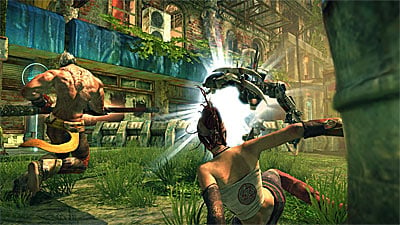
When Trip needs to get across a ledge, Monkey tosses her aggressively over. At times, you can even use her as bait to attract robot patrols to come out before you attack. These are only a few minor illustrations. Though you play as Monkey, you can use Trip’s expertise to scout out upcoming locations, stun robotic enemies, and generally make minor mischief. It’s Monkey who’ll be doing the heavy lifting (it’s good to see chivalry has survived the robot apocalypse).
Enslaved: Odyssey to the West is one part action, one part platformer, and one part chess game. Monkey is strong, but he’s still flesh and bone. He carries a staff to hammer his foes (or shoot them if he finds ammo), but you won’t be able to handle more than a few foes by yourself. More often you’ll attempt to get the drop on enemies by taking alternate routes, sneak attacking, and using “borrowed” weapons from foes. Most fights will probably combine some stealth and scouting with Trip’s robotic dragonfly with a quick attack by Monkey and a God of War-style Quick-time event to finish off enemies. He’s strong and capable, while his enemies are strong and numerous – it’s one of those ‘if your follower dies you die’ scenarios that seems reminiscent of parts of Resident Evil and a handful of other titles. Let’s just hope it’s not as frustrating as protecting Spunky in Rocko’s Modern Life (SEGA reference anyone?).
Ninja Theory is going all out for this project with several big names attached to motion capture work, voice talent, and especially story. The narrative is adapted from an old Chinese folktale, and Ninja Theory is pulling in Alex Garland of 28 Days Later fame to pen the adaptation. Gameplay seems cobbled together from elements of games as diverse as Mark of Kri, Tenchu Stealth Assassins, Batman: Arkham Asylum, and a dozen others. We’re still at least a few months away from the Enslaved: Odyssey to the West hitting the market, but there’s plenty to get excited over. Development is just taking off and there’s already enough big-name talent, top-tier subject matter, and classic gameplay influences to fill a slave freighter. Enslaved: Odyssey to the West is currently scheduled to arrive in stores by the end of 2010.
Game Features:
